The Acoustic Nomads Pass Through Wellfleet
The Acoustic Nomads have a unique vision: to bring together folkloric sounds from Appalachia to Argentina with contemporary improvisation, jazz, and newgrass. “We’re combining music from South America and North America to create a real panoply of styles,” says bassist Noah Harrington. They will perform at Wellfleet Preservation Hall (335 Main St.) on Thursday, Oct. 26, at 7 p.m.
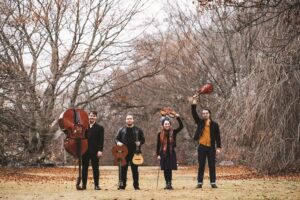
The ensemble is currently a quartet: Harrington, Maurizio Fiore Salas on guitar and Venezuelan cuatro, Ethan Setiawan on mandolin, and Clara Rose on violin. The four met at the Berklee College of Music. Members have roamed in and out of the band since it started: Harrington says the Nomads used to be a sextet that recorded two albums. As a quartet, he says, the band is a “leaner, meaner machine.”
Their album Quartet was released earlier this year. One of the songs is called “Otilio — Jota de los Dos Corazones.” “It’s a song from the folkloric tradition of the eastern part of Venezuela,” says Fiore Salas. “For the longest time it hasn’t really left the 30 square miles where it originated, where it was performed as a religious tradition every year during the spring solstice.” In the tune, mandolin, violin, cuatro, and bass collaborate delicately, building musical layers that feel folkloric and modern at the same time.
The band isn’t afraid to explore music that’s far from them “geographically and culturally,” Fiore Salas says. “We’re interested in respecting it and presenting it to broad audiences.”
It’s part of the band’s mission to help audiences start exploring. “I want to provide people with a glimpse behind the veil of questions they never thought to ask,” Harrington says. “The primary emotion that we want to convey to our audience is a sense of joy and connection.”
Tickets are $25 at wellfleetpreservationhall.org. —Eve Samaha
Weaving a ‘Tapestry of Sound’
The four members of the chamber ensemble Courante, who will perform at the Wellfleet Public Library (55 West Main St.) on Saturday, Oct. 28 at 4 p.m., play instruments that belong to another era: the baroque.
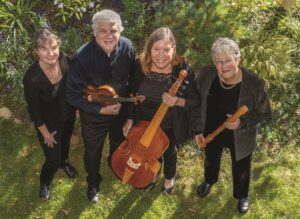
David Gable plays a restored 18th-century violin with a replica of a baroque bow made by Donald Mackenzie, a master bowmaker who lives in Brewster. (There are very few authentic baroque bows in existence, says Gable, and most of them are in museums.) The other musicians play period versions of modern instruments: Jan Elliott plays the recorder; Molly Johnston plays the viola da gamba, the ancestor of the modern cello; and Brittany Lord plays the harpsichord.
Chamber music, says Gable, is especially rewarding: “It’s so personal,” he says. Without a conductor, the group shares the effort of decision-making — if they don’t agree on something in their interpretation of the music, they try out different approaches and settle on something that feels right to everyone. “You own the music when you put that much into it,” he says.
For Gable, part of the appeal of baroque chamber music is its complexity. “I like to compare it to a painting by an artist like Kandinsky, who would take certain shapes and explore all the possibilities of those shapes,” he says. “That’s what a lot of baroque composers do.”
The group was named for the triple-meter dance that often appears in baroque music. In choosing the name, the ensemble found a diagram that outlined the steps of the dance. “It looked like it could be on the wall at the Museum of Modern Art,” says Gable. It’s the interplay of those unique Baroque shapes — both visual and auditory — that allow the group to weave what Gable describes as a “tapestry of sound.”
The ensemble will present a program titled “Family Ties” that features compositions by three musical families of the 17th and 18th centuries: the Gibbonses, the Purcells, and the Bachs. The closing piece is a trio sonata by Johann Sebastian Bach, written for his son Wilhelm Friedemann to practice on the organ.
The concert is free, with limited seating. See courantecapecod.com and wellfleetlibrary.org for more information. —Dorothea Samaha
Surf Rats at Alias Gallery
“Surf Rats,” a group exhibition currently on view at Alias Gallery (64 Main St., Orleans), features artwork about surfing. Most of the artists are surfers themselves.
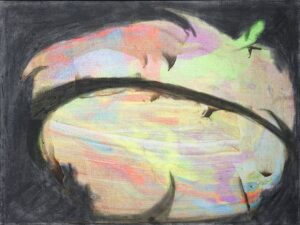
Gallery owner Chris Kelly, one of the artists in the show (and creative director of the Independent), describes the exhibition as a community event. There are professional artists, hobbyists, and creative types working at different levels of accomplishment across a wide variety of media. Its spirit of inclusivity attracted a shoulder-to-shoulder crowd at the opening reception on a rainy Saturday evening.
Katherine Driscoll, one of the artists in attendance at the opening, both paints and surfs. “They’re both activities that make me happy and help me get out of my mind,” she says. Her painting Girl in the Ripper Suit depicts a woman walking through a Mexican surfing town holding a surfboard over her head. The cars in the distance introduce an urban atmosphere, a surprising take on a surfing painting.
I asked a few of the artists — including Driscoll, Kelly, and Matt Rivers, the owner of Pump House Surf Shop in Orleans — to define “surfer art.” They were all noncommittal: “it can be many things” was the consensus. Certainly, that’s the case for the works on display. But there are also some throughlines in the exhibition — and within surf culture’s well-defined aesthetic sense — which I would say include a lot of fluorescent color, crisp linework, and flat shapes.
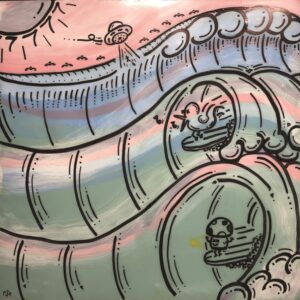
Many artists in the exhibition respond to the subject literally through images of surfers or waves. Others approach the topic not through imagery but through styles associated with surf culture, like G. Love’s graffitiesque, text-based paintings in hot colors and Andy Howell’s graphic image of a skull.
Rivers’s work fits particularly well within a surfing vernacular, both in terms of subject and style. The vibe is playful in Cosmic Vibrations, a painting of three stacked waves. The space is populated with a miniature UFO and a bird on a surfboard; the imagery is rendered in graphic black lines recalling comics. Surfer art — like its close cousin, skater art — seemingly moves with ease between boundaries of fine art, illustration, and design.
Sawyer Van Ness, age nine, is the youngest artist in the show. “This is my first exhibition,” he says. His painting, Tube of Death, loosely refers to tube riding. A black claw-like shape circles around a fluorescent-colored expanse of light in the background. Like a surfer catching a wave, Van Ness catches the right balance in this painting, gracefully navigating two dramatically different color worlds.
The exhibition is on view through Nov. 5. See aliasgallery.com for information. —Abraham Storer
Thor Jensen’s Practical Magic
Thor Jensen wants you to know that many of his ceramic pieces are “not child-friendly” — but not for the reasons you might think.
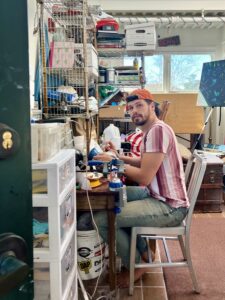
“Some of them are studded with nails or wrapped with barbed wire,” says Jensen, whose work is on view at Studio Lacombe (237 Commercial St., Provincetown) this weekend. “I’ve hurt myself picking them up when I’m not paying attention. They have to be handled with intention.”
Intention runs throughout Jensen’s work, with a variety of shapes, forms, and decorative motifs. He speaks of some of the pieces as “vessels” or “receptacles” for the spirits and energies he communicates with in his spiritual practice. “I make things for spirits to find a home or place to rest,” he says. The decoration of each vessel is related to the nature of the spirit. Chains might decorate an object to house a spirit that needs to be bound or confined, or one that has a binding effect on others. Jensen describes similar traditions in cultures as disparate as ancient Rome and present-day Thailand.
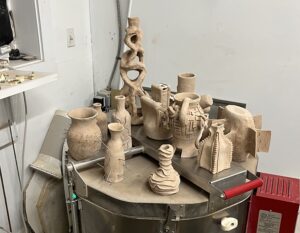
Not all of Jensen’s work is esoteric or metaphysical. As a self-described “big gay nerd,” Jensen also cites fantasy fiction including J.R.R. Tolkien’s The Silmarillion and the writings of H.P. Lovecraft as inspiration for some of the objects he creates. “Sometimes I come across a description of a magical object in a story I’m reading and start thinking about how I can make it real,” he says. His academic background in marine biology is also manifested in pieces shaped like sea sponges.
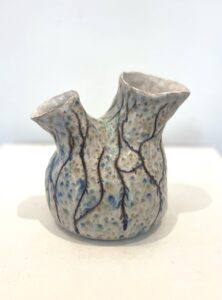
There will be a reception at Studio Lacombe on Friday, Oct. 27 from 6 to 8 p.m.; the show is on view until Oct. 30. See studiolacombe.com for information. —John D’Addario



